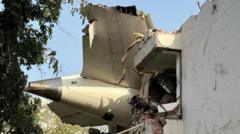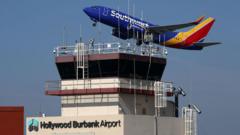The US Federal Aviation Administration (FAA) affirmed the safety of fuel control switches in Boeing aircraft, despite concerns raised by a preliminary investigation on the tragic Air India crash in June that resulted in 260 fatalities. The crash of Air India Flight 171, which occurred shortly after take-off from Ahmedabad airport, has been one of the most significant aviation disasters in recent years.
Investigators revealed that nearly instantaneously after takeoff, the fuel supply to the Boeing 787-8 Dreamliner engines was interrupted, leading to a loss of thrust. This incident has heightened scrutiny over the switches that modulate the fuel flow to the engines.
The preliminary report from the India Aircraft Accident Investigation Branch (AAIB) indicated that the switches were inadvertently toggled from "run" to "cut-off," severely impairing the aircraft's performance. Historical reports from the FAA had previously urged, although not mandated, Boeing operators to examine the locking feature of these switches to prevent unintentional manipulation—a step that Air India did not undertake, according to initial assessments.
In an internal communication, the FAA stated that while its 2018 advisory highlighted an issue regarding the placement of the locks on fuel control switches, it does not classify this as an unsafe design warranting immediate directives for Boeing aircraft, including the 787 model. The FAA affirmed its commitment to sharing any pertinent information with international aviation bodies.
Notably, cockpit voice recordings indicated confusion among the flight crew, with one pilot questioning the other about the fuel cutoff action, which the colleague denied executing. The report did not clarify how both switches went from "run" to "cut-off" concurrently during flight.
The doomed flight, en route to London Gatwick airport, tragically crashed into a medical college one minute after departure. Only one British national survived the incident. A comprehensive report by investigators is anticipated within a year, as they dive deeper into the crash's circumstances.
As the aviation community awaits further findings, the focus remains on the broader implications for flight safety, regulatory measures, and the resilient standards maintained by Boeing.
Investigators revealed that nearly instantaneously after takeoff, the fuel supply to the Boeing 787-8 Dreamliner engines was interrupted, leading to a loss of thrust. This incident has heightened scrutiny over the switches that modulate the fuel flow to the engines.
The preliminary report from the India Aircraft Accident Investigation Branch (AAIB) indicated that the switches were inadvertently toggled from "run" to "cut-off," severely impairing the aircraft's performance. Historical reports from the FAA had previously urged, although not mandated, Boeing operators to examine the locking feature of these switches to prevent unintentional manipulation—a step that Air India did not undertake, according to initial assessments.
In an internal communication, the FAA stated that while its 2018 advisory highlighted an issue regarding the placement of the locks on fuel control switches, it does not classify this as an unsafe design warranting immediate directives for Boeing aircraft, including the 787 model. The FAA affirmed its commitment to sharing any pertinent information with international aviation bodies.
Notably, cockpit voice recordings indicated confusion among the flight crew, with one pilot questioning the other about the fuel cutoff action, which the colleague denied executing. The report did not clarify how both switches went from "run" to "cut-off" concurrently during flight.
The doomed flight, en route to London Gatwick airport, tragically crashed into a medical college one minute after departure. Only one British national survived the incident. A comprehensive report by investigators is anticipated within a year, as they dive deeper into the crash's circumstances.
As the aviation community awaits further findings, the focus remains on the broader implications for flight safety, regulatory measures, and the resilient standards maintained by Boeing.




















